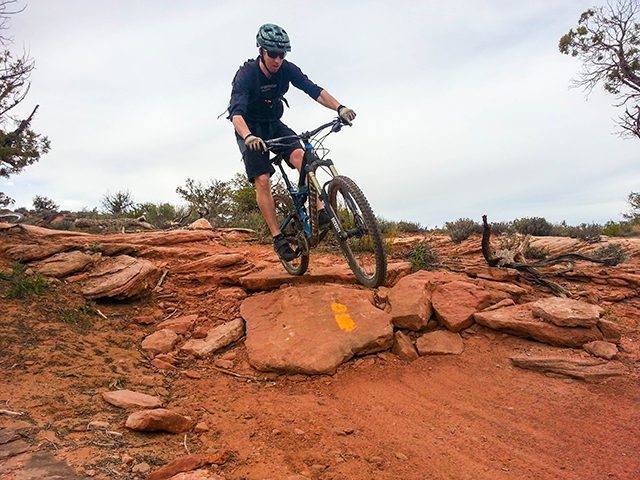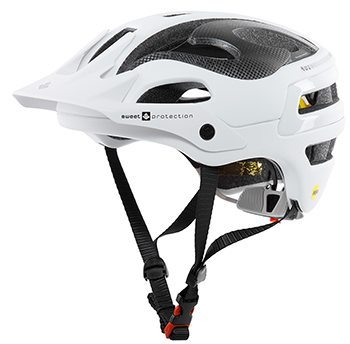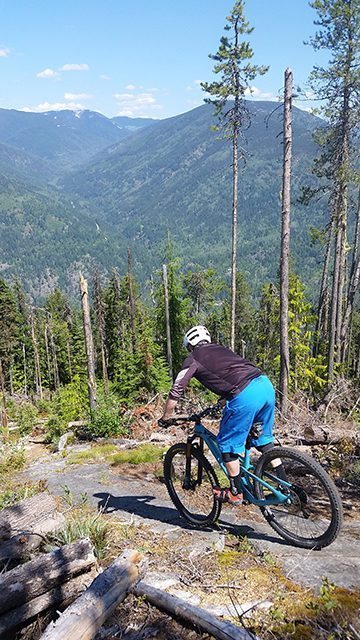Smith Forefront

MSRP: $260
Blister’s Measured Weight (Medium): 331 g (non-MIPS version)
I reviewed the Forefront a while back, and I’m including that helmet in this comparison since Smith now offers a MIPS version. With that in mind, this isn’t an entirely fair comparison since I rode in the non-MIPS version. I’d expect this helmet with MIPS to run slightly hotter, and the fit might be a smidge different.
Fit on the Forefront is a bit more on the round side of the spectrum, but not as round as, for example, Bell helmets. The inside of the Forefront is much more uniform than most helmets due to the use of their Koroyd construction, which is essentially a bunch of little straws that are molded into the shape of a helmet and then capped with a thin layer of EPS foam.
The Forefront uses Smith’s “Vaporfit” retention system, which uses a standard dial in the back. I’ve been using the Forefront for a while, and the system has held up fine. Like a few of the other helmets, it has 3 positions of vertical adjustment, and I’m comfortably using the middle position.
In terms of protection, it’s tough to assess the Forefront and it’s Koroyd construction. Smith claims that the construction of the Forefront makes it protect better, but Consumer Reports actually rated the Forefront below several EPS-only helmets in their independent testing. So is it better? It seems the jury is still out, and this is another situation where I’d like to see companies release their testing results so we can see for ourselves how the helmet stacks up.

I’ve heard some complaints about the Forefront’s ventilation, but I think it’s actually pretty good in the context of mountain biking. I’d venture a guess that most of the complaints are comparing it to a heavily carved out XC or road helmet, whereas I’m comparing it to “all mountain” type helmets like the Giro Feature. It doesn’t have as many vents as the Lazer, but particularly at slower speeds, it keeps my head relatively cool. It also does a good job at sweat management, so no complaints there.
The straps on the Forefront are pretty straightforward and offer a good range of adjustment. The Forefront’s visor is almost as good as the Giro Features; it has two positions, and it’s easy to flip the visor between them.
The Forefront integrates with some Smith sunglasses, it comes with a goggle strap, and it has a ¼-20 mount on the top for mounting whatever cameras, lights, or other gadgets you want perched atop your head.
Sweet Protection Bushwhacker Carbon

MSRP: $265
Blister’s Measured Weight (Medium) 390 g
Sweet Protection is relatively new to the bike helmet game, but they’ve come out with a few high end options, with the Bushwhacker series aimed at the Enduro crowd.
Like the Scott Vivo Plus, the Bushwhacker sits low on my head, and I feel like it’s more “around” my head than on top of it. It fits slightly larger than some of the other Mediums in this test, but I still felt like I could get a pretty good fit with it. However, the inside of the Bushwhacker is fairly sculpted, and while that probably helps with airflow, it also meant that I got some uncomfortable pressure points at my temples.
Like the Forefront, the Bushwhacker incorporates some different materials in an effort to increase protection — in this case, that means carbon fiber. Some relatively thin carbon panels cap the EPS, which according to Sweet Protection improves the helmet’s ability to deal with impacts and makes it safer. But as with other improvements to protection, it’s tough to asses the actual benefits of this claim without seeing data from the tests and comparing it to other helmets.
The retention system on the Bushwhacker might be the best in the test — it’s not dramatically different, but I felt like it did the best job of getting a death grip on my head. Like most others, it involves a dial and a 3-position vertical adjustment.

Ventilation on the Bushwhacker is on the good side of average. I’d say it’s roughly on par with the Smith Forefront. Where the Bushwhacker falls short is when it comes to sweat management — minimal padding and a large cutout in the front of the helmet mean that all of my sweat ends up in my eyes. I honestly didn’t realize how much sweat I produced until I rode in this helmet. It’s like the firehose scene in UHF, where I’m the kid, and the firehose is filled with my sweat.
Straps on the Bushwhacker are laid out slightly differently than other helmets in that the rear of the straps enter the side of the helmet, rather than at a point in the rear. This is similar to the Giro Feature, but the Bushwhacker straps don’t lay nice and flat like the Feature’s do. They are, however, more adjustable. The visor on the Bushwhacker is fine, although it’s not adjustable at all. The Bushwhacker doesn’t have any integration for gadgets, but goggles work fine on it.
It’s worth noting that Sweet Protection has a significant update to the Bushwhacker in the pipeline, and improved sweat management / ventilation was a big priority. We look forward to reviewing the Bushwhacker 2.0, and will report back.
Bottom Line
At the risk of sounding artificially diplomatic, all of these helmets have their selling points. The Smith Forefront and the Sweet Protection Bushwhacker Carbon are the most expensive, but they have some different materials that arguably increase safety. The Giro Feature isn’t the best ventilated helmet, but it sure is priced to sell. And the Lazer Oasiz has lots of vents and easy integration for lights and cameras.
But at the end of the day, it’s the Scott Vivo Plus that came out on top for me. It fits me really well, and the ventilation and sweat management, while not best in class, are pretty good. I’m not overly concerned with strapping gadgets to my head, so the lack of light or camera integration isn’t a big deal for me. And although it’s not the least expensive helmet, it’s still priced reasonably, and it ticks the least important checkbox — I think it looks pretty good.
But really, the Scott was my favorite largely due to fit, and just because it fits me doesn’t mean it’ll fit you. Every helmet fits a little differently, and we’ll say it again: pick the helmet that fits you best.

A different approach to the same issue, I’d be curious to see how 6D’s ODS technology compared. They have been VERY well received in the moto world, and have a helmet comparable to those you reviewed (model = ATB maybe?).
Next time, maybe!
Hey Tom,
We’re hoping to get some time in a 6D helmet soon. Their design looks really smart, and my initial reaction is that it has to be right near the top in terms of protection against hard impacts. They’re definitely bigger, heavier helmets though, so I’ll have to see how that plays out on the trail.
-Noah